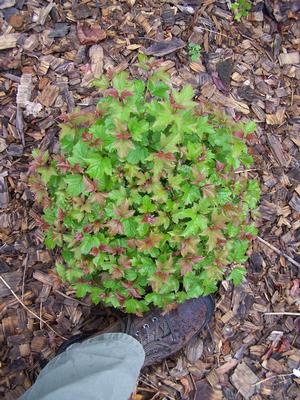Printed at http://www.quackingrassnursery.com/index.cfm/
Viburnum opulus var. americanum 'Jewell Box'
American Cranberrybush Viburnum
Plant Type:
DECIDUOUS SHRUBSViburnum opulus var. americanum 'Jewell Box' - This is a lovely dwarf American Cranberrybush Viburnum that grows a mere 18 inches tall with a spread of 24 to 30 inches over the course of many years. Clean green summer leaves bridge bronze-red new growth, white spring flowers and burgundy fall color. We haven't seen any fruit yet... maybe we will but if this true dwarf is trapped as a genetic juvenile then maybe we won't! 'Jewell Box' is perfect in the foundation, the rock garden or a step down shrub as the grounded tier before larger background shrubs. It's a wonderful addition in the world of Viburnums. Site in plenty of sun planted in fertile draining soil. Cutting grown.
Characteristics and Attributes for Viburnum opulus var. americanum 'Jewell Box'
Season of Interest (Flowering)
- Spring
Season of Interest (Foliage)
- Spring / Summer / Autumn
Autumn Interest
- Autumn Leaf Color
Nature Attraction
- Honey Bees & Native Bees
Light
- Full Sun
- Mostly Sunny
Attributes
- Hedgerow
- Edging
- Foundation
- Rock Garden
- Labyrinth
- Shrub Border
Growth Rate in the Garden
- Slow
Soil
- Draining
- Fertile
Origins
- Garden Origin
Propagated By
- Cutting Grown
Genus Overview: Viburnum
Common Name: Viburnum
Viburnum. This genus is full of fantastic, multi-season garden worthy shrubs. Garden heroes. Spring flowers, often large and showy, many with heady sweet fragrance are arranged in cymes. Some smell of musk (Viburnum dilatatum) while others produce no fragrance at all. Flowers are followed with berries. If late season and autumn berries are desired then planting two of a species will ensure fruit set; for instance, Viburnum dilatatum 'Erie' and V. dilatatum 'Michael Dodge' will pollinate each other and produce fruit. Viburnum cassinoides is closely allied with V. nudum; but if the flowering times do not overlap then there will be no fruit. However, if you plant V. nudum 'Winterthur' in proximity with V. nudum var. angustifolium, 'Longwood', 'Moonshine' or 'Pink Beauty' berries will abound. Another interesting example is V. lantana which crosses with V. burejaeticum and vice versa. Any V. plicatum f. tomentosum selection such as 'Shasta' or 'Shoshoni' will pollinate with all other V. plicatum f. tomentosum selections like 'Copper Ridges or 'Pink Beauty'. But if you were to plant two 'Shasta' side by side with no other V. plicatum f. tomentosum in near proximity then your effort will be fruitless. As with almost all in the universe of plants there are exceptions. There is one viburnum which appears to be self-fruitful, Viburnum setigerum the Tea Viburnum. Another interesting exception to the rule is Viburnum nudum 'Pink Beauty' which is also self-fruitful - a departure from its siblings. And on the other spectrum are two I can think of off-hand that are barren, Viburnum plicatum 'Roseum' and Viburnum plicatum 'Kern's Pink'. Oftentimes, the dwarf viburnums reamin in a juvenile state and do not produce fruit. All Viburnum of any size that do produce fruit are magnificent in the late season garden. And they feed all manner of birds. Larger, denser shrubs provide cover and nesting opportunities. Nearly all Viburnum have terrific autumn foliage colors, too. Viburnums are members of Caprifoliaceae. All prefer part to full sun and fertile soils. All are cutting grown. Many thanks to Gary Ladman of Classic Viburnums who generously set us straight regarding some of the details we had originally incorrectly lauded... ya can't know everything!



